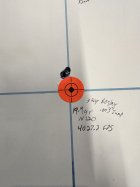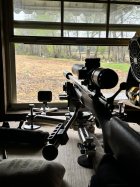Been running 223Als as my primary squirrel blasters for a while now, but feeling the need to build a .20.
The 20 practical would be the easy option, but being I do most of my squirrel hunting in CA I'm limited to lead free bullets. That leaves the Hornady 24 NTX and the Nosler 32 BTLF as my 2 top choices (if I can ever get a hold of the Nosler 32 BTLF, seems like they've been out of stock for 2+ years now.) The 20 practical and 20 tactical seem like overkill on powder capacity for the 24s or 32s, which is why I'm leaning towards a Vartarg build. Thought about the 20-222, but IMO the 20-222 is just too close to the 20 practical in case capacity to justify buying all new brass and dies when I could simply buy a different bushing and use my stockpiles of 223 components for the 20 practical. If I could use the 40gr lead bullets, I'd lean towards a 20 practical or tactical build for the extra case capacity for the heavier bullet, but since I can't the Vartarg makes the most sense IMO.
Since the Vartarg seems to excel with faster burning powders like AA2200, RL7, and H4198, is there a point where barrel length becomes too long for those faster burning powders and friction starts slowing things down? I was leaning towards a 26" barrel, but wondering if that might be too long for the Vartarg. Doing some searches it seems 22- 24" seems to be the most common barrel lengths for Vartarg builds, with a few outliers at 25-26". Haven't found any posts anywhere from someone who's tried a 26-28" barrel with the Vartarg. I'm not opposed to a 28" barrel provided it's not overly long and will start slowing things down with the typical faster burning Vartarg powders. Thoughts?
Still trying to decide on twist rate as well, since the lead free bullets are long for their weight they need a faster twist to stabilize-- especially if I'm using it on a cold morning 20' above sea level. I had that issue with my 17HMR with a standard off the shelf 9 twist Lilja barrel with the lead free NTX ammo. When the DA was under about 3000' the 15.5 NTX lead free would only manage 2-3" groups @ 50Y, but the 17gr Vmax would make tiny groups regardless of atmospheric conditions. Drive up to somewhere where the DA was above 3000' and suddenly the 15.5 NTX starts shooting tiny groups at 50Y. A couple stability calculators backed up my observations that the 9 twist wasn't adequate for the 15.5 NTX in all atmospheric conditions. I had Lilja make a custom 7 twist barrel and now it shoots both the 15.5gr NTX and 17gr Vmax into tiny groups at 50Y, even on a cold morning where the DA is -1200'. I have no desire to run into this issue with the .20 Vartarg build, so I'm leaning towards a 9 or 9.25 twist to ensure stability with the Nosler 32 BTLFs at around 3550fps on cold mornings at sea level.
Appreciate any input on both the length and twist, as I'm looking to order a barrel blank this week.
The 20 practical would be the easy option, but being I do most of my squirrel hunting in CA I'm limited to lead free bullets. That leaves the Hornady 24 NTX and the Nosler 32 BTLF as my 2 top choices (if I can ever get a hold of the Nosler 32 BTLF, seems like they've been out of stock for 2+ years now.) The 20 practical and 20 tactical seem like overkill on powder capacity for the 24s or 32s, which is why I'm leaning towards a Vartarg build. Thought about the 20-222, but IMO the 20-222 is just too close to the 20 practical in case capacity to justify buying all new brass and dies when I could simply buy a different bushing and use my stockpiles of 223 components for the 20 practical. If I could use the 40gr lead bullets, I'd lean towards a 20 practical or tactical build for the extra case capacity for the heavier bullet, but since I can't the Vartarg makes the most sense IMO.
Since the Vartarg seems to excel with faster burning powders like AA2200, RL7, and H4198, is there a point where barrel length becomes too long for those faster burning powders and friction starts slowing things down? I was leaning towards a 26" barrel, but wondering if that might be too long for the Vartarg. Doing some searches it seems 22- 24" seems to be the most common barrel lengths for Vartarg builds, with a few outliers at 25-26". Haven't found any posts anywhere from someone who's tried a 26-28" barrel with the Vartarg. I'm not opposed to a 28" barrel provided it's not overly long and will start slowing things down with the typical faster burning Vartarg powders. Thoughts?
Still trying to decide on twist rate as well, since the lead free bullets are long for their weight they need a faster twist to stabilize-- especially if I'm using it on a cold morning 20' above sea level. I had that issue with my 17HMR with a standard off the shelf 9 twist Lilja barrel with the lead free NTX ammo. When the DA was under about 3000' the 15.5 NTX lead free would only manage 2-3" groups @ 50Y, but the 17gr Vmax would make tiny groups regardless of atmospheric conditions. Drive up to somewhere where the DA was above 3000' and suddenly the 15.5 NTX starts shooting tiny groups at 50Y. A couple stability calculators backed up my observations that the 9 twist wasn't adequate for the 15.5 NTX in all atmospheric conditions. I had Lilja make a custom 7 twist barrel and now it shoots both the 15.5gr NTX and 17gr Vmax into tiny groups at 50Y, even on a cold morning where the DA is -1200'. I have no desire to run into this issue with the .20 Vartarg build, so I'm leaning towards a 9 or 9.25 twist to ensure stability with the Nosler 32 BTLFs at around 3550fps on cold mornings at sea level.
Appreciate any input on both the length and twist, as I'm looking to order a barrel blank this week.












